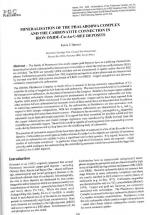Добрый день, Коллеги. Важное сообщение, просьба принять участие. Музей Ферсмана ищет помощь для реставрационных работ в помещении. Подробности по ссылке
Mineralisation of the Phalaborwa complex and the carbonatite connection in iron oxide-Cu-Au-U-REE deposits
The family of Proterozoic iron-oxide copper-gold deposits have as a unifying characteristic mineralisation which is dominated by titanium-poor iron oxides in which the total rare earth elements (REE) are enriched. The REE are typically LREE enriched and are concentrated in apatite and/or discrete REE phases. Carbonatites typically contain low-Ti02 magnetite and apatite as minor phases and are characterised by elevated total REE with extreme enrichment of LREE over HREE. Copper and gold are not, however, commonly associated with carbonatites.
The 2060Ma Phalaborwa Complex in South Africa is unusual in having economic concentrations of Cu sulphides in a plug of magnetite-rich foskorite and carbonatite. The maximum enrichment in Cu is found in the transgressive carbonatite, the last phase of intrusion in the Complex. Bornite is the major copper sulphide in the banded carbonatite whereas chalcopyrite predominates in the transgressive carbonatite ore body. Apatite, noble metals (PGE and Au) and U are also beneficiated. Copper and Au have been reported from other southern African carbonatites but economic levels of these metals have not been identified. In addition to containing anomalous concentrations of Cu, the carbonatites at Phalaborwa are also anomalous with respect to their isotopic compositions. With few exceptions carbonatites are characterised by eSr and em values indicating derivation from mantle sources - Phalaborwa has elevated eSr and negative eNd suggesting substantial inputs from old crustal reservoirs. It is argued that these anomalies are possibly related and that the copper mineralisation and crustal isotopic signatures were introduced by fluids evolved from the crystallising carbonatite magma. These fluids would be capable of leaching metals from surrounding country rocks during fenitisation and cycling them into the solidifying body of carbonatite.
The presence of carbonatite-sourced fluids have been identified or suspected in a few of the Fe oxide Cu-Au deposits. Carbonatites are small igneous bodies whereas Fe oxide-Cu-Au deposits are typically of enormous size and so carbonatites are unlikely to play a significant role in their genesis. It is argued, however, that studies of carbonatite complexes - in particular where high level fenitisation zones are exposed - might provide useful analogues for understanding the mineralising processes which have produced the large iron oxide-Cu-Au-U-REE deposits.




